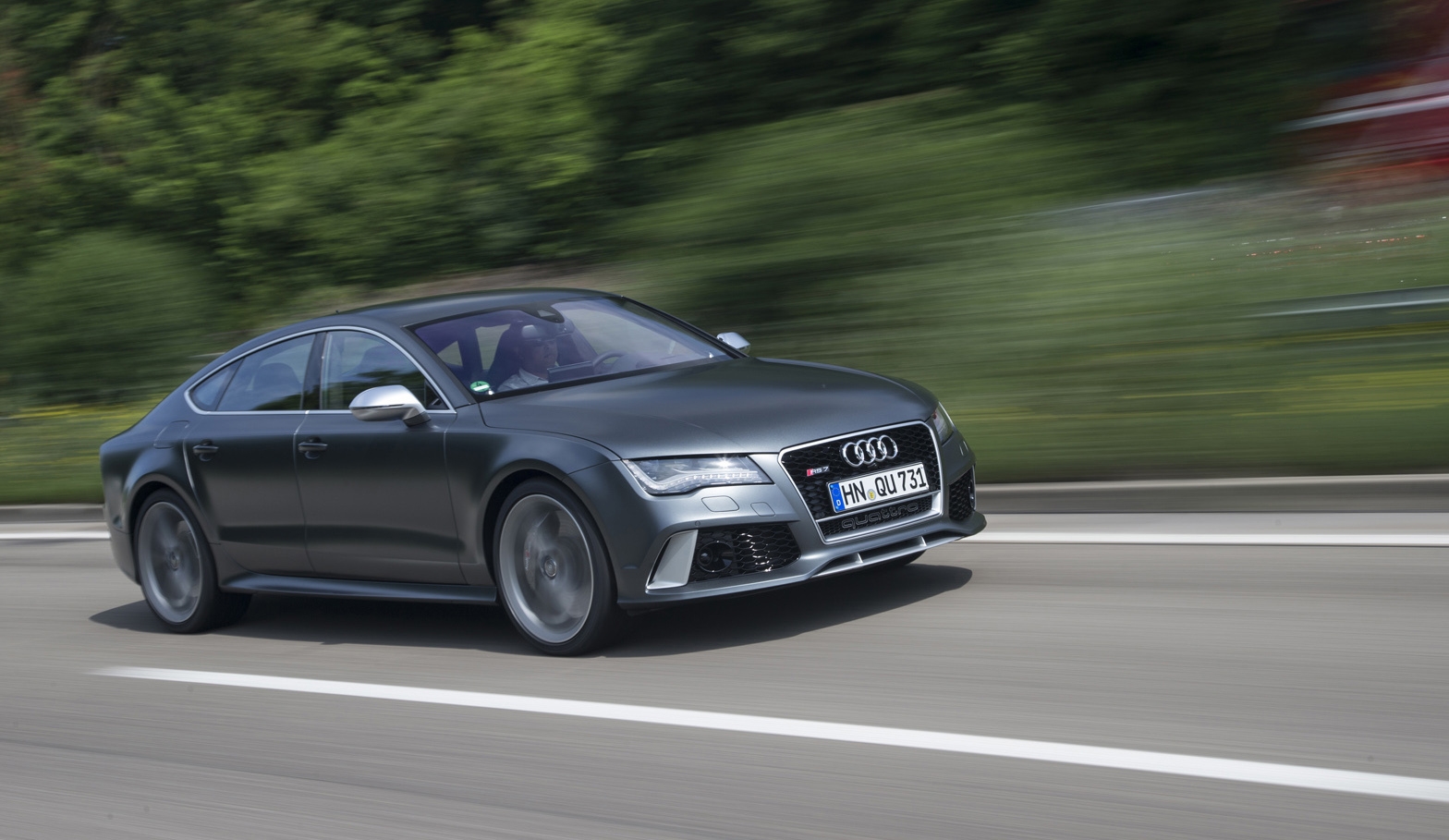Absolutely Audi
Torque. It’s funny how a thing so difficult to explain in words to anyone without a degree in advanced mechanical engineering can be defined so emphatically with one push of a car’s ‘go’ pedal.
Suddenly it’s crystal clear. Forget the maths; more torque simply makes acceleration faster. In some cases, a lot faster.
This seems like a good time for some kind of practical demonstration. We’ll need a car, and not just any car. Leave your miles-per-gallon hat at home because, for this, we’ll need a big engine. With turbochargers. And preferably a loud exhaust for good measure. And so, let me introduce our willing volunteer for today’s lesson: the new Audi RS 7.
You might recognise its shell from the love-it-or-loathe-it A7 Sportback, albeit on a light dose of steroids. The RS 7 is pleasantly subtle in its muscularity, adding to the A7’s silhouette here and there without going overboard. If the Mercedes CLS 63 AMG looks a bit too brutish for your tastes, chances are you’ll like the Audi a lot.
Under the bonnet is, what I can only assume to be, the kind of explosion-making device that Scotland wants to ban. Audi calls it the 4.0-litre twin-turbo V8 from the RS 6 Avant. I call it a weapon of mass destruction (of super-unleaded). It’s about 20 horsepower down on the larger, normally-aspirated V10 engine in the old RS 6, but it has more peak torque and – crucially – a lot more wallop lower in the rev range. It’s technically quite a bit more efficient, too – mustn’t forget that.
Back to the torque demo, and we’re on a narrow, winding German back road behind a tractor doing 15mph. The RS 7’s 2.1-metre width is just too much to squeeze down the side of the meandering farmer and his trailer of loosely packed hay bales. Good to know some forms of driving torture aren’t reserved only for the British.
Eventually, Herr. Farmer swings out to the left and cuts back across into one of his fields (no indicators), leaving an empty road ahead. For a moment it’s like I’m wearing an iron boot and there’s an electro-magnet under the accelerator. I hit the power, hard, and with no perceptible turbo lag from 3,000rpm, several things happen at once. A thunderstorm breaks beneath the boot, unleashing an epic baritone roar through optional sports exhausts. I’m pushed into the figure-hugging leather sports seat so hard that I can feel its shoulder-blade high RS logo pressing into my back. The car is charging at the next corner, incensed, like a rudely awoken grizzly bear, and given the inertia it’s carrying, I hit the brakes.
With a monumental and truly awful squeal, the stone-cold carbon ceramic anchors struggle to haul the car up to a safe speed for the corner. It turns out the optional – and huge – 420mm upgraded discs need a good bit of heat in them to work properly, making the standard steel ‘wave’ discs a better everyday bet. Fortunately, as the RS 7 and I barrel around the bend and re-deploy enough turbocharged torque to rip the tarmac to shreds, I find that there’s an almost endless reserve of grip and traction.
Audi fits all its RS models with quattro four-wheel drive, and in the 7 it gains a ‘sports differential’ at the back axle. I watched the moving display model with accompanying video three times and, to be honest, I’m still not quite sure what it does. Because the power is split between four wheels rather than some of its rivals’ two though, the RS 7 puts around half the power down through each fat tyre and makes it almost impossible to wheelspin. That’s a win for safety as well as granting unbelievable acceleration. Reaching 62mph from rest in 3.9 seconds is incredible for a car that – with two people, fluids and a tank of petrol on board – weighs around 2.2 tonnes. Its top speed is electronically limited, but without the cap the RS 7 would – astonishingly – top 200mph
It’s not perfect. It’s inescapably heavy during hard cornering, the centre console looks flat and dated, the Dynamic suspension mode is much too unforgiving, the sat-nav is frequently late with its instructions and the steering lacks any real feel at all despite its undoubted accuracy.
But within the boundaries of what the RS 7 is designed for, namely to be the RS 6’s less practical but more aggressive and sporting GT-esque cousin, it’s very impressive. It even has four power sockets so everyone on board can charge a device. But the one thing that defines the RS 7 more than anything else is torque. As science lessons go, I’d happily revisit this one.
FACTS AT A GLANCE
Model: Audi RS 7 Sportback, from £83,495 on the road.
Engine: 4.0-litre twin-turbo V8 petrol producing 552bhp and 516lb.ft.
Transmission: 8-speed Tiptronic automatic driving all four wheels.
Performance: Top speed 155-189mph (limited, spec-dependent), 0-62mph in 3.9 seconds.
Fuel economy: 28.8mpg.
CO2 rating: 229g/km.
Latest posts by Sally - Silversurfer's Editor (see all)
- Should smacking a child be banned in England and Northern Ireland? - April 17, 2024
- Enjoy the best of the UK on a Shearings coach holiday - April 17, 2024
- Blueberry & Lemon Curd Bread and Butter Pudding - April 16, 2024
- Navigating the World with What3Words: A Lifeline for Older Generations - April 15, 2024
- Parsley Box – Bringing you time for the things you love! - April 12, 2024





















